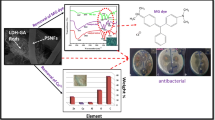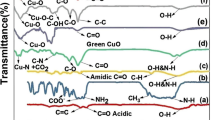Abstract
Fine powder of magnetite nanoparticles (MNPs) was doped with different contents of copper (Cu) through a mat of graphene oxide (GO) nanosheets. These compositions were incorporated into electrospun nanofibrous membranes of polycaprolactone (PCL). Mechanical properties were measured, and examining the ability of these nanofiber membranes to remove methylene blue (MB) dyes from aqueous solutions was also assessed. TEM of the resulting nanofibers has a diameter of the order of 300 nm. Moreover, the morphological features of membranes showed that diameters were varied upon the variation of dopant (Cu ions) starting from 0.35–1.06 μm and 1.8–3.9 μm at no Cu reaching 0.19–0.45 μm and 0.75–1.42 μm for the highest contribution of Cu, whereas GO scattered grains of 0.56–1.5 μm were detected. The tensile strength was changed accordingly and reached around 8.96 ± 0.45 MPa, while the toughness achieved 4.69 ± 0.29 MJ/m3 at the highest additional dopant. The designed nanofibrous membrane was able to remove 95.1% MB after 36 min of continuous exposure, while the reusability indicated that the composition was stable after 5 times of removal with efficiency around 90.1% for the 0.8Cu–MNPs–GO@PCL. The antibacterial efficiency was also investigated against both E.coli and S. aureus, and the inhibition zone recorded around 11.4 ± 1.5 and 11.1 ± 1.7 mm in dark and 15.6 ± 2.1 and 13.6 ± 1.8 mm, respectively, at the highest contribution of Cu dopant. This behavior of the manipulated nanofibrous membrane indicates that tailoring of multi-functional nanomaterials could be reached via designing scaffold-based electrospun technique.












Similar content being viewed by others
References
Kianfar, A.H.; Arayesh, M.A.: Synthesis, characterization and investigation of photocatalytic and catalytic applications of Fe3O4/TiO2/CuO nanoparticles for degradation of MB and reduction of nitrophenols. J. Environ. Chem. Eng. 8(1), 103640 (2020)
Lavín, A., et al.: High proportion ZnO/CuO nanocomposites: Synthesis, structural and optical properties, and their photocatalytic behavior. Surf. Interfaces 17, 100367 (2019)
Lakkaboyana, S.K., et al.: Synthesis of copper oxide nanowires-activated carbon (AC@CuO–NWs) and applied for removal methylene blue from aqueous solution: Kinetics, isotherms, and thermodynamics. J. Inorg. Organomet. Polym Mater. 29(5), 1658–1668 (2019)
Kumar, S., et al.: Curcumin functionalized CuO/Ag nanocomposite: Efficient visible light Z-scheme photocatalyst for methyl orange degradation. Environ. Nanotechnol. Monit. Manag. 12, 100236 (2019)
He, K., et al.: Graphene hybridized polydopamine-kaolin composite as effective adsorbent for methylene blue removal. Compos. B Eng. 161, 141–149 (2019)
Fadillah, G., et al.: Electrochemical removal of methylene blue using alginate-modified graphene adsorbents. Chem. Eng. J. 378, 122140 (2019)
Chen, W., et al.: Promising copper oxide-histidine functionalized graphene quantum dots hybrid for electrochemical detection of hydroquinone. J. Alloy. Compd. 777, 1001–1009 (2019)
Cahino, A.M., et al.: Characterization and evaluation of ZnO/CuO catalyst in the degradation of methylene blue using solar radiation. Ceram. Int. 45(11), 13628–13636 (2019)
Aragaw, B.A.; Dagnaw, A.: Copper/reduced graphene oxide nanocomposite for high performance photocatalytic methylene blue dye degradation. Ethiop. J. Sci. Technol. 12(2), 125 (2019)
Zhang, W., et al.: Preparing graphene oxide–copper composite material from spent lithium ion batteries and catalytic performance analysis. Res. Chem. Intermed. 44(9), 5075–5089 (2018)
Yousaf, S., et al.: Synthesis and characterization of double heterojunction-graphene nano-hybrids for photocatalytic applications. Ceram. Int. 45(14), 17806–17817 (2019)
Yoo, J., et al.: Instantaneous integration of magnetite nanoparticles on graphene oxide assisted by ultrasound for efficient heavy metal ion retrieval. Ultrason. Sonochem. 64, 104962 (2020)
Yew, Y.P., et al.: Green biosynthesis of superparamagnetic magnetite Fe3O4 nanoparticles and biomedical applications in targeted anticancer drug delivery system: A review. Arab. J. Chem. 13(1), 2287–2308 (2020)
Sahmani, S., et al.: Effect of magnetite nanoparticles on the biological and mechanical properties of hydroxyapatite porous scaffolds coated with ibuprofen drug. Mater. Sci. Eng. C Mater. Biol. Appl. 111, 110835 (2020)
Gahrouei, Z.E.; Labbaf, S.; Kermanpur, A.: Cobalt doped magnetite nanoparticles: Synthesis, characterization, optimization and suitability evaluations for magnetic hyperthermia applications. Physica E 116, 113759 (2020)
Ramadan, R.: Preparation, characterization and application of Ni-doped magnetite. Appl. Phys. A 125(9), 1–8 (2019)
Ramadan, R.: Physical study of cobalt ferrite and its application in purification of water. Appl. Phys. A 125(12), 1–8 (2019)
Alfredo Reyes Villegas, V., et al.: Synthesis and characterization of magnetite nanoparticles for photocatalysis of nitrobenzene. J. Saudi Chem. Soc. 24(2), 223–235 (2020)
Rouhi, M., et al.: Design and performance of polypyrrole/halloysite nanotubes/Fe3O4/Ag/Co nanocomposite for photocatalytic degradation of methylene blue under visible light irradiation. Optik 212, 164721 (2020)
Iqbal, S., et al.: Controlled synthesis of Ag-doped CuO nanoparticles as a core with poly(acrylic acid) microgel shell for efficient removal of methylene blue under visible light. J. Mater. Sci. Mater. Electron. 31, 8423–8435 (2020)
Nuengmatcha, P., et al.: Enhanced photocatalytic degradation of methylene blue using Fe2O3/graphene/CuO nanocomposites under visible light. J. Environ. Chem. Eng. 7(6), 103438 (2019)
Ateia, E.E., et al., Synthesis and Characterization of EPDM/Ferrite Nanocomposites. Journal of Inorganic and Organometallic Polymers and Materials, 2019.
Ateia, E.E., et al.: Optimizing the physical properties of cobalt/graphene nanocomposites for technological applications. Appl. Phys. A 125(8), 1–8 (2019)
Mansour, S.F., et al.: Microstructural, morphological behavior and removal of Cr(VI) and Se(IV) from aqueous solutions by magnetite nanoparticles/PVA and cellulose acetate nanofibers. Appl. Phys. A 126(3), 1–14 (2020)
Menazea, A.A.; Ahmed, M.K.: Silver and copper oxide nanoparticles-decorated graphene oxide via pulsed laser ablation technique: Preparation, characterization, and photoactivated antibacterial activity. Nano-Struct. Nano-Objects 22, 100464 (2020)
Al-Wafi, R.; Mansour, S.F.; Ahmed, M.K.: Mechanical, microstructural properties and cell adhesion of Sr/Se-hydroxyapatite/graphene/polycaprolactone nanofibers. J. Thermoplast. Compos. Mater. (2020). https://doi.org/10.1177/0892705720912781
Ahmed, M.K.; Mansour, S.F.; Al-Wafi, R.: Nanofibrous scaffolds of epsilon-polycaprolactone containing Sr/Se-hydroxyapatite/ graphene oxide for tissue engineering applications. Biomed. Mater. 19, 103151–103163 (2020)
Menazea, A.A.; Ahmed, M.K.: Wound healing activity of Chitosan/Polyvinyl Alcohol embedded by gold nanoparticles prepared by nanosecond laser ablation. J. Mol. Struct. (2020). https://doi.org/10.1016/j.molstruc.2020.128401
Menazea, A.A.; Abdelbadie, S.A.; Ahmed, M.K.: Manipulation of AgNPs coated on selenium/carbonated hydroxyapatite/ε-polycaprolactone nano-fibrous via pulsed laser deposition for wound healing applications. Appl. Surf. Sci. 508, 145299 (2020)
Ahmed, M.K.; Menazea, A.A.; Abdelghany, A.M.: Blend biopolymeric nanofibrous scaffolds of cellulose acetate/epsilon-polycaprolactone containing metallic nanoparticles prepared by laser ablation for wound disinfection applications. Int. J. Biol. Macromol. 155, 636–644 (2020)
Ahmed, M.K., et al.: Physical and biological changes associated with the doping of carbonated hydroxyapatite/polycaprolactone core-shell nanofibers dually, with rubidium and selenite. J. Mater. Res. Technol. 9, 3710–3723 (2020)
Ahmed, M.K., et al.: Complex relationship between alumina and selenium-doped carbonated hydroxyapatite as the ceramic additives to electrospun polycaprolactone scaffolds for tissue engineering applications. J. Alloy. Compd. 801, 70–81 (2019)
Ahmed, M.K., et al.: Tuning the mechanical, microstructural, and cell adhesion properties of electrospun ε-polycaprolactone microfibers by doping selenium-containing carbonated hydroxyapatite as a reinforcing agent with magnesium ions. J. Mater. Sci. 54(23), 14524–14544 (2019)
Zou, R., et al.: Novel design of porous hollow hydroxyapatite microspheres decorated by reduced graphene oxides with superior photocatalytic performance for tetracycline removal. Solid State Sci. 99, 106067 (2020)
Xie, Y.Y., et al.: Development and antibacterial activities of bacterial cellulose/graphene oxide-CuO nanocomposite films. Carbohydr. Polym. 229, 115456 (2020)
Ahmed, M.K., et al.: Tuning the composition of new brushite/vivianite mixed systems for superior heavy metal removal efficiency from contaminated waters. J. Water Process Eng. 34, 101090 (2020)
Ahmed, M.K., et al.: Gold as a dopant in selenium-containing carbonated hydroxyapatite fillers of nanofibrous epsilon-polycaprolactone scaffolds for tissue engineering. Int. J. Pharm. 577, 118950 (2020)
Mansour, S.F., et al.: Structure and cell viability of Pd substituted hydroxyapatite nano particles. Biomed. Phys. Eng. Express 4(4), 045008 (2018)
Shaban, N.Z., et al.: Design, DNA binding and kinetic studies, antibacterial and cytotoxic activities of stable dithiophenolato titanium(IV)-chitosan nanocomposite. J. Mol. Liq. 287, 111002 (2019)
Menazea, A.A.; Mostafa, A.M.; Al-Ashkar, E.A.: Effect of nanostructured metal oxides (CdO, Al2O3, Cu2O) embedded in PVA via Nd:YAG pulsed laser ablation on their optical and structural properties. J. Mol. Struct. 1203, 127374 (2019)
Menazea, A.A., et al.: Precipitation of silver nanoparticles in silicate glasses via Nd:YAG nanosecond laser and its characterization. J. Non-Cryst. Solids 513, 49–54 (2019)
Abdelbar, M.F., et al.: Halogen bond triggered aggregation induced emission in an iodinated cyanine dye for ultra sensitive detection of Ag nanoparticles in tap water and agricultural wastewater. RSC Adv. 8(43), 24617–24626 (2018)
Abou-Zeid, R.E., et al.: Surfactant-assisted poly(lactic acid)/cellulose nanocrystal bionanocomposite for potential application in paper coating. J. Renew. Mater. 6(4), 394–401 (2018)
Salama, A.; Aljohani, H.A.; Shoueir, K.R.: Oxidized cellulose reinforced silica gel: new hybrid for dye adsorption. Mater. Lett. 230, 293–296 (2018)
Kursunlu, A.N.; Ozmen, M.; Guler, E.: Novel magnetite nanoparticle based on BODIPY as fluorescent hybrid material for Ag(I) detection in aqueous medium. Talanta 153, 191–196 (2016)
Abdullah, N.H., et al.: Facile and green preparation of magnetite/zeolite nanocomposites for energy application in a single-step procedure. J. Alloy. Compd. 719, 218–226 (2017)
An, X., et al.: Synthesis of nano-fibrillated cellulose/magnetite/titanium dioxide (NFC@Fe3O4@TNP) nanocomposites and their application in the photocatalytic hydrogen generation. Appl. Catal. B 206, 53–64 (2017)
Abdullah, N.H., et al.: A facile and green synthetic approach toward fabrication of starch-stabilized magnetite nanoparticles. Chin. Chem. Lett. 28(7), 1590–1596 (2017)
Zheng, B., et al.: Effect of γ-aminopropyltriethoxysilane on the properties of cellulose acetate butyrate modified acrylic waterborne coatings. React. Funct. Polym. 154, 104657 (2020)
Yang, S., et al.: Enhanced permeability, mechanical and antibacterial properties of cellulose acetate ultrafiltration membranes incorporated with lignocellulose nanofibrils. Int. J. Biol. Macromol. 151, 159–167 (2020)
Wang, D., et al.: Preparation of cellulose acetate-polyacrylonitrile composite nanofibers by multi-fluid mixing electrospinning method: morphology, wettability, and mechanical properties. Appl. Surf. Sci. 510, 145462 (2020)
Ullah, A., et al.: Manuka honey incorporated cellulose acetate nanofibrous mats: Fabrication and in vitro evaluation as a potential wound dressing. Int. J. Biol. Macromol. 155, 479–489 (2020)
Sattary, M., et al.: The effect of collector type on the physical, chemical, and biological properties of polycaprolactone/gelatin/nano-hydroxyapatite electrospun scaffold. J. Biomed. Mater. Res. B Appl. Biomater. 107, 933–950 (2018)
Gorodzha, S.N., et al.: Investigation of the morphology and structure of porous hybrid 3D scaffolds based on polycaprolactone involving silicate-containing hydroxyapatite. J. Surf. Invest. 12(4), 717–726 (2018)
Shoueir, K., et al.: Thallium and selenite doped carbonated hydroxyapatite: microstructural features and anticancer activity assessment against human lung carcinoma. Ceram. Int. 46(4), 5201–5212 (2020)
Solanki, P., et al.: Nano-fertilizers and their smart delivery system. In: Nanotechnologies in Food and Agriculture. Springer, pp. 81–101 (2015)
Menazea, A.A.; Ahmed, M.K.: Nanosecond laser ablation assisted the enhancement of antibacterial activity of copper oxide nano particles embedded though Polyethylene Oxide/Polyvinyl pyrrolidone blend matrix. Radiat. Phys. Chem. 174, 108911 (2020)
Chatterjee, A.K.; Chakraborty, R.; Basu, T.: Mechanism of antibacterial activity of copper nanoparticles. Nanotechnology 25(13), 135101 (2014)
Shoueir, K., et al.: Tailoring the surface reactivity of plasmonic Au@TiO2 photocatalyst bio-based chitosan fiber towards cleaner of harmful water pollutants under visible-light irradiation. J. Clean. Prod. 230, 383–393 (2019)
Omrani, N.; Nezamzadeh-Ejhieh, A.: A comprehensive study on the enhanced photocatalytic activity of Cu2O/BiVO4/WO3 nanoparticles. J. Photochem. Photobiol. A 389, 112223 (2020)
Panicker, S., et al.: On demand release of ionic silver from gold-silver alloy nanoparticles: fundamental antibacterial mechanisms study. Mater. Today Chem. 16, 100237 (2020)
Zakria, M.A., et al.: Ultra-thin silver nanoparticles film prepared via pulsed laser deposition: synthesis, characterization, and its catalytic activity on reduction of 4-nitrophenol. Surf. Interfaces 19, 100438 (2020)
Karthik, C., et al.: Green synthesized rGO-AgNP hybrid nanocomposite—an effective antibacterial adsorbent for photocatalytic removal of DB-14 dye from aqueous solution. J. Environ. Chem. Eng. 8(1), 103577 (2020)
Menazea, A.A.; Mostafa, A.M.; Al-Ashkar, E.A.: Impact of CuO doping on the properties of CdO thin films on the catalytic degradation by using pulsed-Laser deposition technique. Opt. Mater. 100, 109663 (2020)
Acknowledgements
The authors extend their appreciation to the Deanship of Scientific Research at King Khalid University, Saudi Arabia, for funding this work through the Research Groups Program under Grant No. R.G.P.1/171/41.
Author information
Authors and Affiliations
Corresponding author
Ethics declarations
Conflict of interest
The authors declare that they have no conflict of interest.
Rights and permissions
About this article
Cite this article
Radwan, H.A., Ismail, R.A., Abdelaal, S.A. et al. Electrospun Polycaprolactone Nanofibrous Webs Containing Cu–Magnetite/Graphene Oxide for Cell Viability, Antibacterial Performance, and Dye Decolorization from Aqueous Solutions. Arab J Sci Eng 47, 303–318 (2022). https://doi.org/10.1007/s13369-021-05363-7
Received:
Accepted:
Published:
Issue Date:
DOI: https://doi.org/10.1007/s13369-021-05363-7




